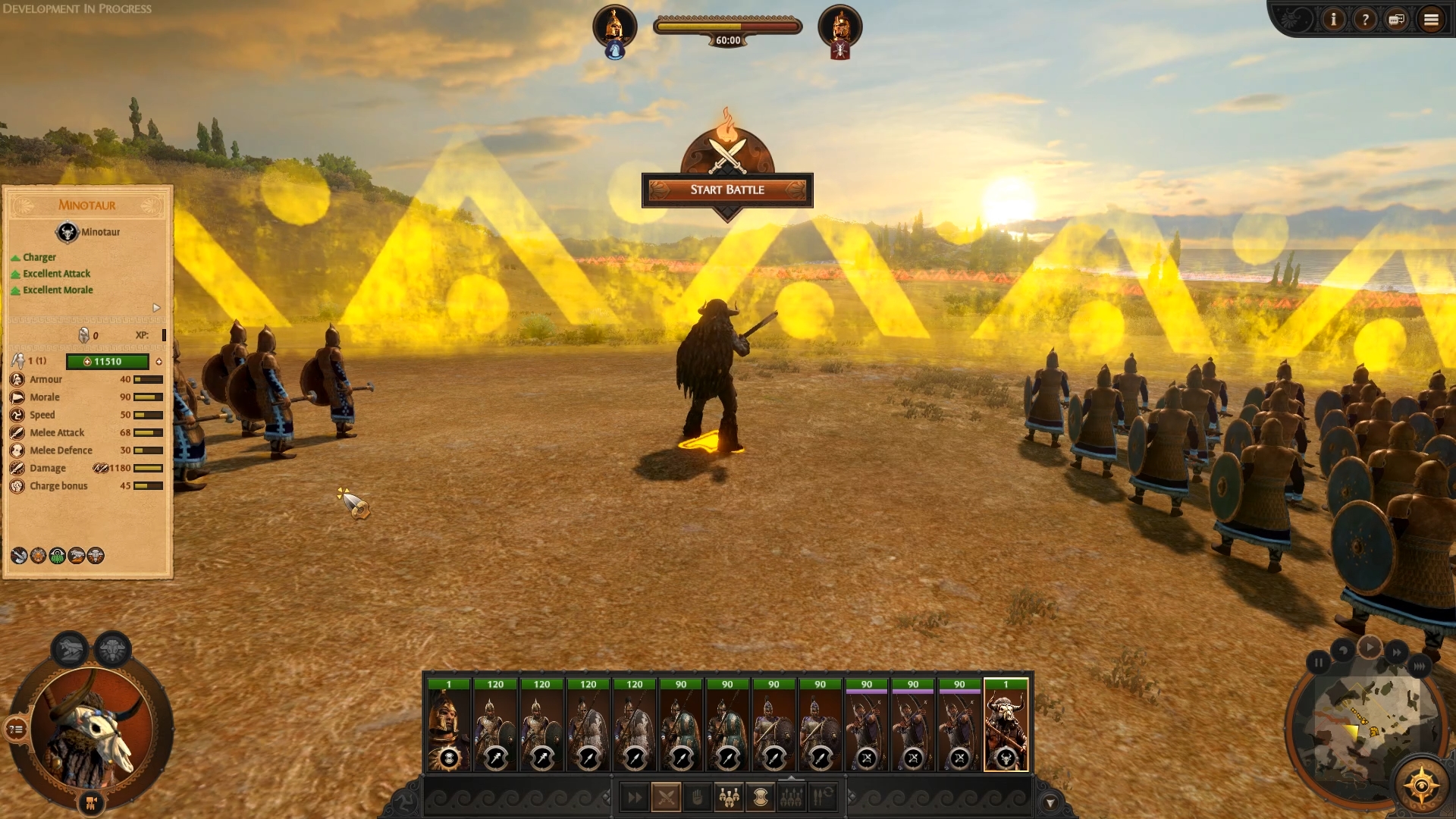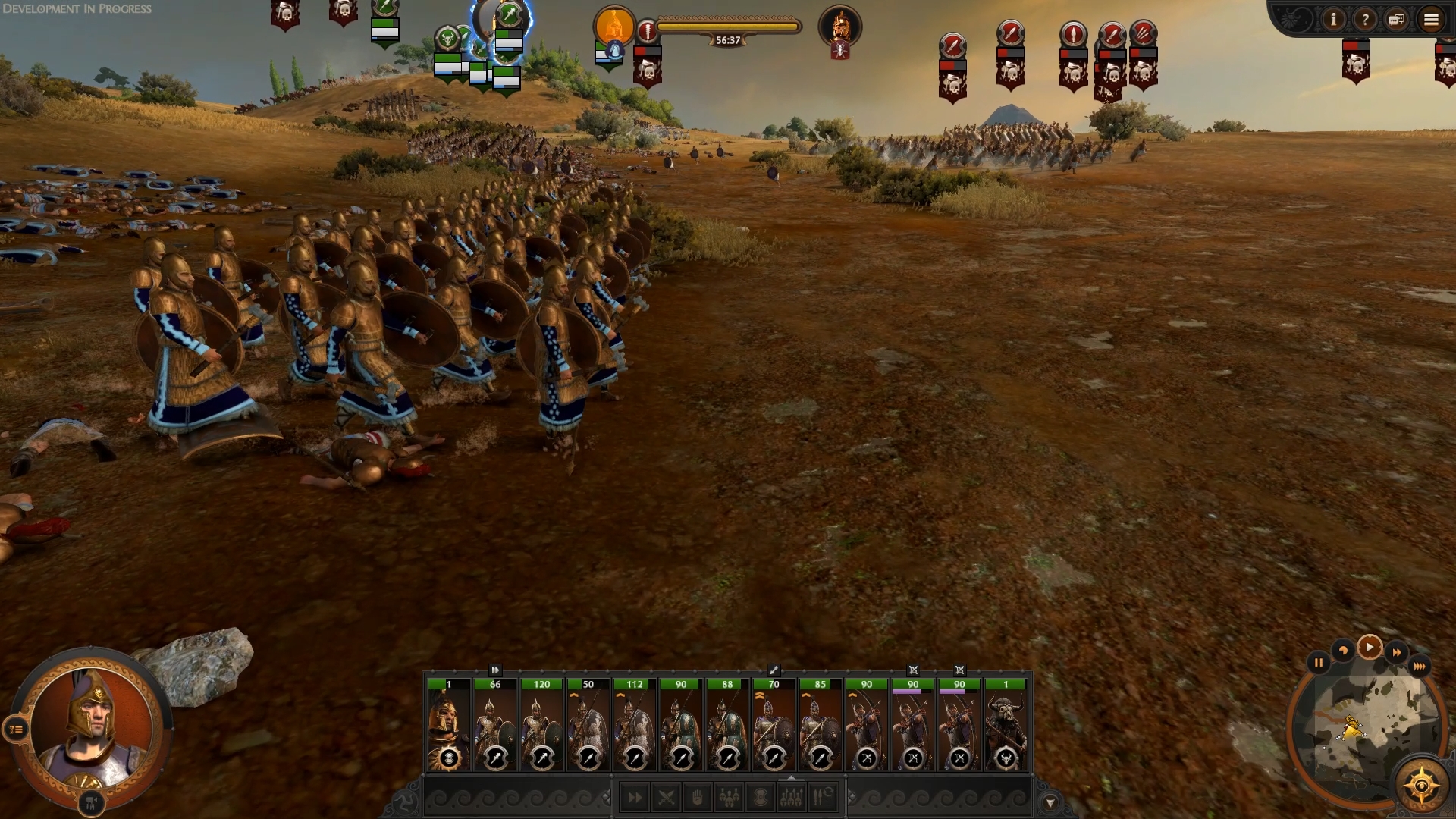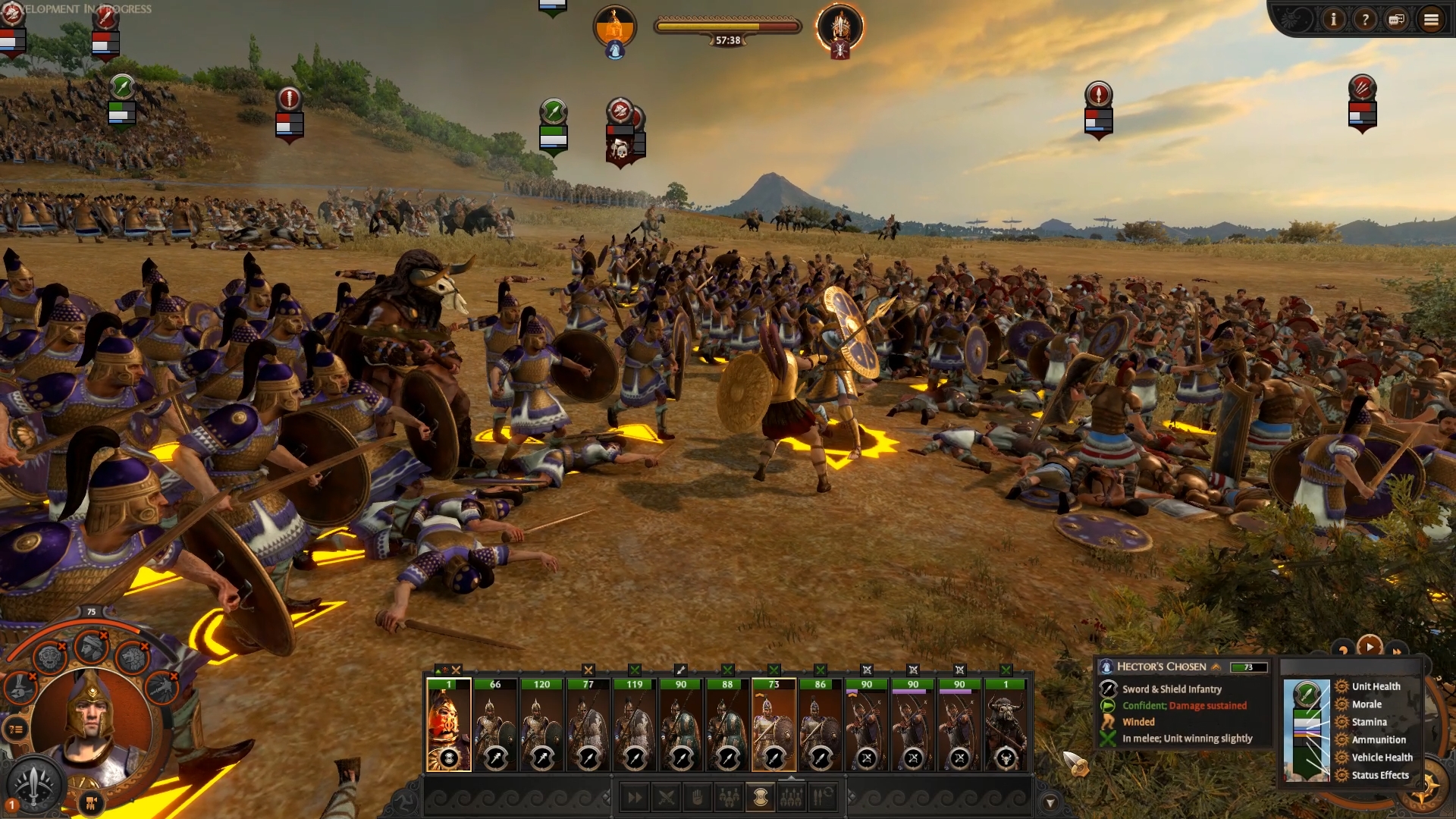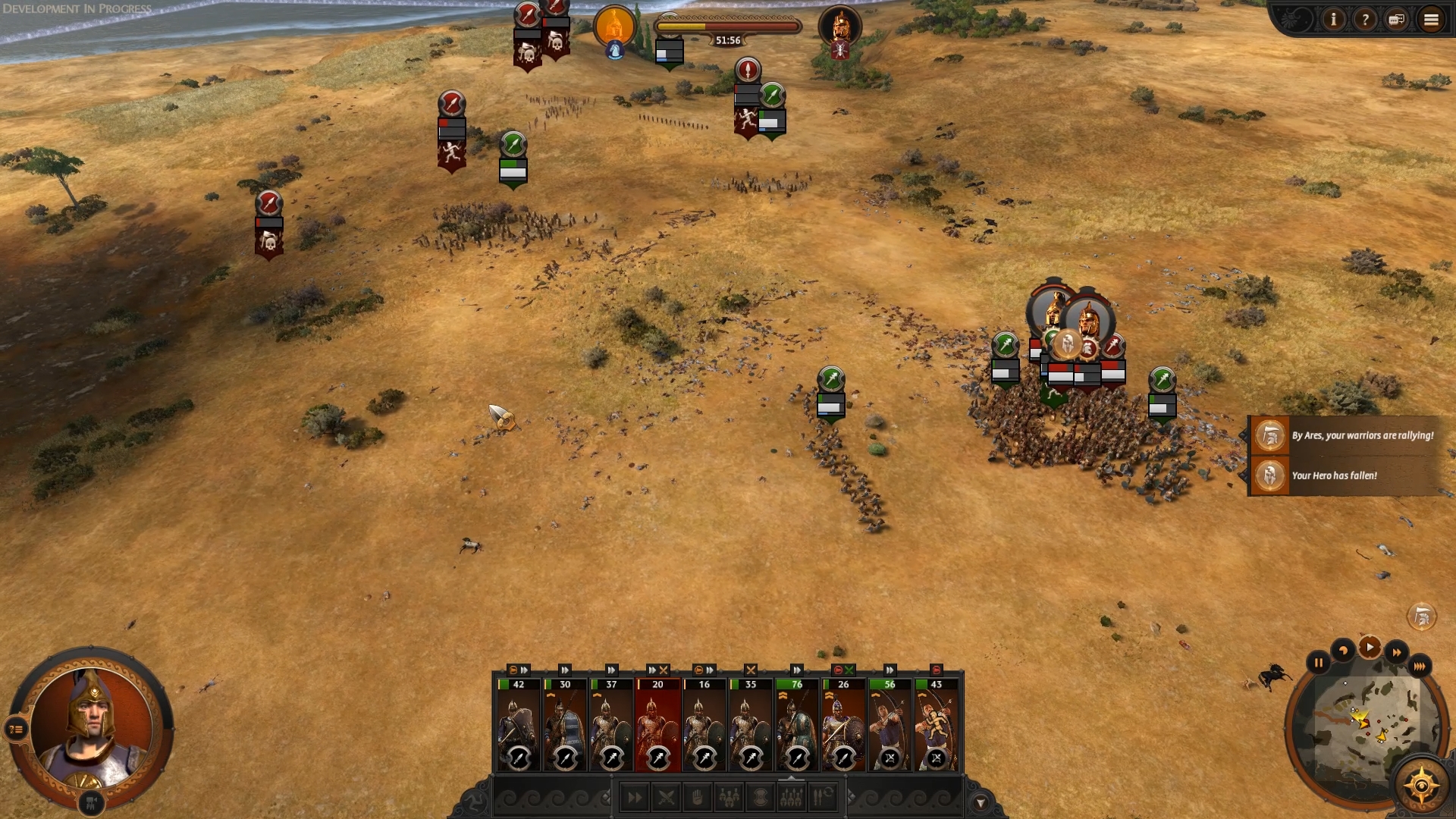Troy, as you might expect, covers the Trojan War off of the Iliad, and is therefore set earlier than any other Total War game so far. When exactly? It’s hard to say, since modern knowledge of Mediterranean history is murky enough that we can’t even be certain there was a Trojan War to begin with. But such evidence as there is points towards “around 1200BCE”. That’s the Bronze Age, that is, and it’s not a time where that many games are set. One of the most charming things about Troy is its approach to both the aesthetics and the mythic quality of the era. Creative Assembly’s Sofia division, for whom Troy is the first standalone Total War outing, are really fond of the idea of “the truth behind the myth”, and have tried to make this feel like a historical game wherever possible. If Three Kingdoms was historical by default, but presented through a mythic lens, then Troy is the other way round, taking the stuff of myth and trying to present it with (usually) archaeological sobriety. While part of me would prefer a game that went balls out on gods and monsters, that part of me has Total War: Warhammer 2, and is welcome to play it whenever it likes. As far as the other part of me is concerned, Troy does a really good job of spinning Homer’s long and weird poems into something convincingly human, while still feeling larger than life. I’ll be following this post up with another based on an interview with developers at CA Sofia, focusing on the game’s theming, art design and story, and on the campaign layer, which I’ve not yet seen in action. For now though, I want to concentrate on the meat beneath the gravy. And just as in any Total War game, that’s the battlefield where the Total Battles of your Total War play out. And pleasingly enough, that takes me back to talking about the Bronze Age. Back in those days, you see, the horse had only just been invented (by the Greek philosopher Peter Horse), and they still hadn’t developed any decent batteries for it yet. So while Troy doesn’t entirely deny you the innate Total War pleasure of smashing a load of armoured quadropeds into a rectangle of blokes, cavalry units are few and far between. They are a treat, to smash some archers up with after you’ve had your main meal. Battles are about infantry, therefore. And to make up for this superficial narrowing of unit variety, your infantry types are way more varied in capability than ever. Most importantly, there are three armour classes: light, medium and heavy. Heavy troops are… well, heavy. They plod around and get tired easily. Light troops, meanwhile, will go down like bundles of sticks in the front line, but can be really fast - Achilles’ Aeginian runners in the demo, for example, might as well have been horses themselves, given the rate at which they scampered about.
Feints with fast-moving troops are important moves, therefore, while flanking - which is centrally emphasised in Troy, with some units being extra good at it, and others either more or less susceptible to it - becomes vital. Terrain is more relevant now, too, as the traditional ‘wooded’ terrain has been joined by sand (which slows foot troops slightly), mud (which slows them a lot, including their ability to turn and charge) and long grass (which can conceal lighter units completely). And don’t forget hills, which rhyme with “kills” for a reason. Most units have at least one special skill or uncommon ability, such as the ability to charge, hide in any terrain, or pierce armour. On top of that, several units have alternating weapon stances, and are thus sort of two units at once. There are swordsman who can hurl javelins when you toggle their alt fire, for example, softening up the opposing line for the mincing to come. There are also shield lads who can do that cool “shields down, swords up” thing the elves do in the opening cutscene of the first Lord of The Rings film, and go from being arrow-resisting tanks to damage dealers in a single cool SCHLING sound. While not a new feature for the series, Troy seems to feature these “transformers” units, as I insist on calling them, more prominently than previous Total Wars. And when units can become functionally different units at the press of a button, it adds a welcome new dimension to the strategic puzzle game of the deployment phase. It also adds a new button to press, however. And to be more precise, another button to remember to press in the thick of the action. While also keeping track of a swarm of infantry units who look pretty similar from 100 metres up in the air, and who are just slightly faster than you expect them to be, zooming around after each other like swarms of Total Wasps. Factor in the question of whose flanking bonus is whose, which spear fighters have armour and which don’t, who can stalk, and where the mud is, and you’re beginning to get an idea of how much there is to bear in mind at any given moment. Then there are the heroes, of course. One of Troy’s pure concessions to myth is the addition of functionally superhuman Mega Lads like Hector, Achilles, Odysseus and the rest, and they’re of vital importance to your performance on the battlefield. Each has a number of abilities on timers, including powerful buffs for your own troops, as well as a super ability (named after the poetic concept of Aristeia) which can be activated after filling a meter by doing lots of swording, putting them temporarily into Beast Mode (this is pictured in the header image, by the way). They’re less powerful compared with normal infantry than Three Kindom’s heroes are, but they can still usually hold their own against walls of enemy soldiers, and more than once my Achilles/Hector battles felt a tiny bit like the wizard sport off of Harry Potter, where the game’s score is decided almost entirely by which of two players can chase down a winged ball first. For a few games, I paid minimal attention to the bulk of my force, concentrating entirely on micromanaging my hero instead, and I tended to perform marginally better. In other games, I managed to outmanoeuvre the enemy pretty decisively, only to have a tooled up nutter with a fancy shield mow his way methodically through all my exhausted units, even as the last members of his own army fled the field. With that said, I don’t think the balance issue here is either fun-ruining, or insurmountable. The main issue is once again split attention, as heroes are too powerful not to want to squeeze every last bit of efficiency from, but not so powerful that you can leave them to do their own thing for long. Another thing I should mention is that the demo battle only had two modes - ’easy’, which was trivial even by the devs’ admission, and ‘hard’, which they rightly warned me was a bruiser, and in my experience at least, a little way above the curve of hard settings in TW games as a whole. Still, I appreciated why the challenge was as stiff as it was. I suspect CA Sofia wanted to showcase as many of Troy’s new tactical variables as possible, and so crafted a scenario which forced you to learn the ins and outs of them all, and which punished you with a big bronze rod if you didn’t make use of them all. Achilles, for example, came to the battle with a force of fast, lightly armed Achaeans who’d become instant dogmeat if you sent them into a classic line-’em-up-and-press-go assault against Hector’s tanky heavy infantry. To win as Achilles, I had to wring everything I could from every unit, and every acre of battlefield. Scampering runners lured club-wielding megaboys through troughs of mud, where they could be weakened with hit-and-run attacks from spearmen before finally reaching my front line. Skirmish lines would retreat past meadows of long grass, drawing in shield-wielders, who would then be perforated from behind by massed javelins. The javelineers, of course, had hidden there earlier while my single cavalry unit harassed Hector’s flank away from the spot. When these moments worked out, they were heroically satisfying. But to pull them off without having the rest of the battlefield collapse into a rout, I had to keep the passage of time dialled down to its lowest possible setting. This meant all the cool clashing and shouting noises faded away, and I lost a lot of the atmosphere the game does so well at generating. In TW: Warhammer 2, I can play to relax, peering imperiously over my ranks of trudging skeletons as they wade lethargically into the enemy, and occasionally dispatching battallions of monsters to trouble spots with lazy sweeps of my invisible gauntlet. Here, at least on hard mode, I don’t think I could get away with that. Despite a long familiarity with the series, I found it hard to ditch the constant sense that I just couldn’t hold enough information in my head at once to make the best of all the possibilities I was being offered by Troy. Some of that, no doubt, will fade with familiarity, as Total War games don’t tend to be masterable in an afternoon. Even with all the visual design effort that’s gone into making troops look distinct, they’re enough alike that it takes time to tell at a glance who does what. Hotkey support, too (which I’ll admit I didn’t remember to look into during the time I played), will be crucial. And hey! Some people, who are just faster than I am, might never experience the sense of being overwhelmed at all. For them especially, Troy’s depth should be a real joy. Newcomers and other sluggish dads, however, should bear in mind that it certainly doesn’t play itself. All in all, if my main criticism of Total War Saga: Troy is that it does too many interesting things, it’s not looking too bad at all. Once I’ve had a crack at the campaign mode and had a chance to build a force up from scratch, I suspect I’m going to have a much more comfortable time with it.






